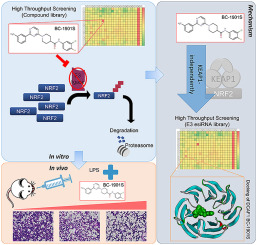Redox Biology ( IF 10.7 ) Pub Date : 2020-03-04 , DOI: 10.1016/j.redox.2020.101485 Yanwen Chen 1 , John W Evankovich 2 , Travis B Lear 3 , Ferhan Tuncer 4 , Jason R Kennerdell 4 , Daniel P Camarco 4 , Morgan S Shishido 4 , Yuan Liu 5 , Bill B Chen 6

|
NRF2 is a master regulator of cellular anti-oxidant and anti-inflammatory responses, and strategies to augment NRF2-dependent responses may beneficial in many diseases. Basal NRF2 protein level is constrained by constitutive KEAP1-mediated degradation, but in the presence of electrophiles, NRF2 ubiquitination is inhibited. Impeded NRF2 degradation increases NRF2 protein, resulting in up-regulation of anti-oxidant gene transcription, and decreased inflammation. KEAP1-independent mechanisms regulating NRF2 stability have also been reported. Here we employed an HTS approach and identified a small molecule, BC-1901S, that stabilized NRF2 and increased its activity. BC-1901S activated NRF2 by inhibiting NRF2 ubiquitination in a KEAP1-independent manner. It further increased NRF2-dependent anti-oxidant gene transcription, and exhibited anti-inflammatory effects in vitro and in vivo. Further, we identified a new NRF2-interacting partner, DDB1 and CUL4 Associated Factor 1 (DCAF1), an E3 ligase that targeted NRF2 for proteasomal degradation. Mechanistically, BC-1901S directly bound to DCAF1 and disrupted NRF2/DCAF1 interaction, thus activating NRF2. These findings provide new insights in NRF2 biology and NRF2 based anti-inflammatory therapy.
中文翻译:

小分子 NRF2 激活剂 BC-1901S 通过 DCAF1/NRF2 轴改善炎症。
NRF2 是细胞抗氧化和抗炎反应的主要调节因子,增强 NRF2 依赖性反应的策略可能对许多疾病有益。基础 NRF2 蛋白水平受到 KEAP1 介导的降解的限制,但在亲电子试剂存在下,NRF2 泛素化受到抑制。 NRF2 降解受阻会增加 NRF2 蛋白,导致抗氧化基因转录上调,并减少炎症。还报道了调节 NRF2 稳定性的独立于 KEAP1 的机制。在这里,我们采用了 HTS 方法并鉴定了一种小分子 BC-1901S,它可以稳定 NRF2 并增加其活性。 BC-1901S 通过以不依赖 KEAP1 的方式抑制 NRF2 泛素化来激活 NRF2。它进一步增加了 NRF2 依赖性抗氧化基因的转录,并在体外和体内表现出抗炎作用。此外,我们还发现了一种新的 NRF2 相互作用伙伴 DDB1 和 CUL4 相关因子 1 (DCAF1),这是一种针对 NRF2 进行蛋白酶体降解的 E3 连接酶。从机制上讲,BC-1901S 直接与 DCAF1 结合并破坏 NRF2/DCAF1 相互作用,从而激活 NRF2。这些发现为 NRF2 生物学和基于 NRF2 的抗炎治疗提供了新的见解。











































 京公网安备 11010802027423号
京公网安备 11010802027423号